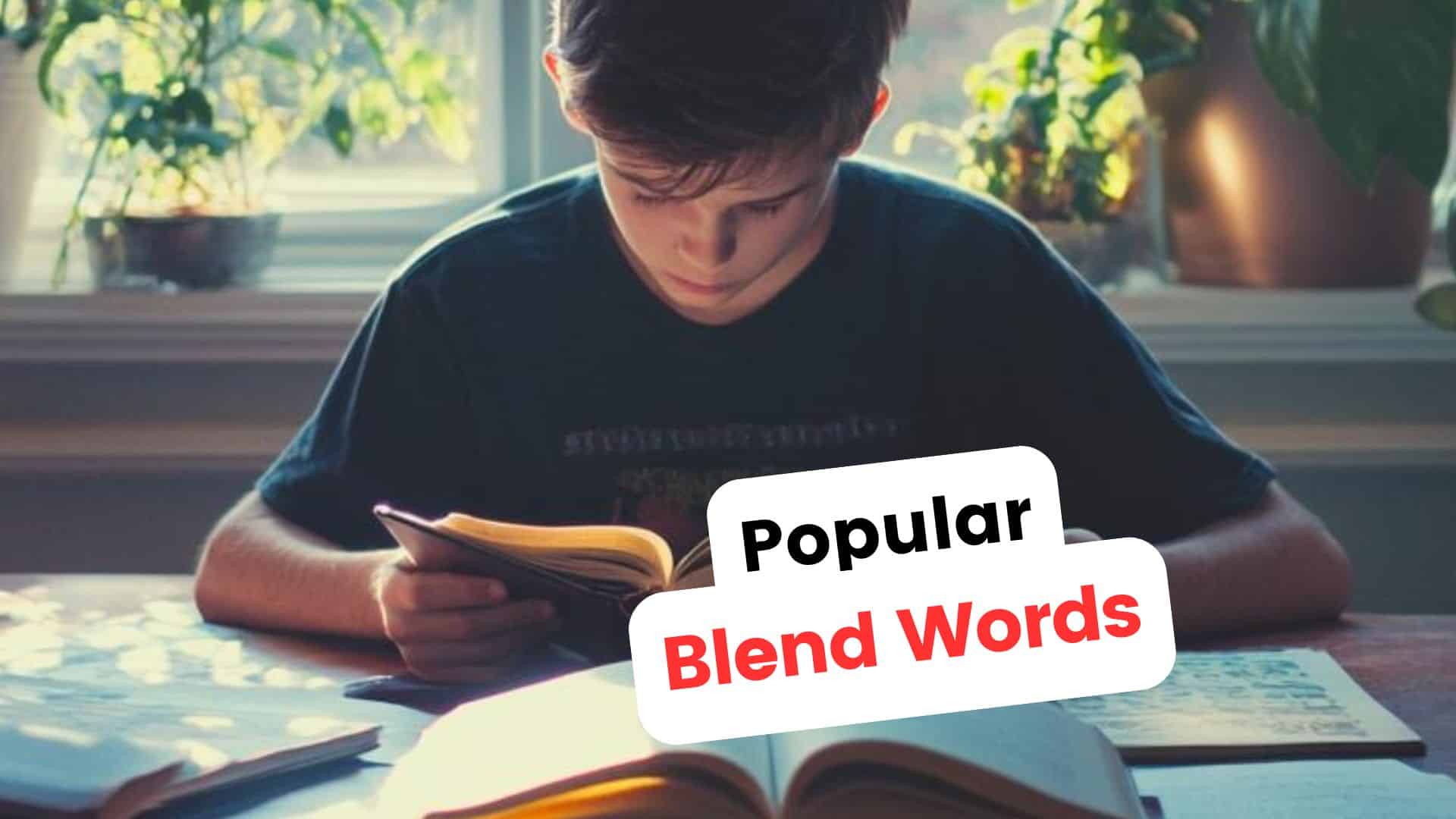This comprehensive guide delves into prevalent blend words in the English language, exploring their origins, meanings, and usage across various contexts.
Language evolves constantly, adapting to express new concepts and phenomena through creative means.
One such linguistic device is the blend word, which combines parts of existing words to create a novel term.
These hybrid words have become ingrained in our daily communication, reflecting cultural shifts, technological advancements, and the ever-changing dynamics of modern life.
Whether you’re a language enthusiast, a learner seeking to enhance your vocabulary, or simply someone curious about language evolution’s intricacies, this blog offers an insightful exploration of these linguistic marvels.
From the ubiquitous “Agitprop” to the topical “Vlog,” blend words offer a concise and expressive way to encapsulate complex ideas.
List of Popular Blend Words

1. Agitprop
- Origin: agitation + propaganda
- Usage: Political context
- Common context: Media and communication
- Example sentence: The agitprop campaign aimed to sway public opinion through provocative messaging.
Blend words like “agitprop” have become instrumental in political communication and propaganda.
These concise terms can convey complex ideological messages and rally support for specific causes or movements.
The seamless fusion of “agitation” and “propaganda” encapsulates the persuasive nature of such campaigns, which often aim to arouse strong emotions and sway public opinion.
2. Blog
- Origin: web + log
- Usage: Online journaling
- Common context: Internet
- Example sentence: She started a travel blog to document her adventures worldwide.
The advent of the “blog” revolutionized how individuals share their thoughts, experiences, and creative expressions with the world.
This blend of “web” and “log” has given rise to a vast online community of bloggers, each with a unique voice and perspective.
Blogs have become platforms for personal storytelling, niche expertise, and even professional journalism, allowing writers to connect with a global audience.
3. Brunch
- Origin: breakfast + lunch
- Usage: Late morning meal
- Common context: Dining
- Example sentence: Let’s meet for brunch this weekend and catch up over mimosas and eggs Benedict.
The concept of “brunch” perfectly captures the fusion of two beloved meal traditions: breakfast and lunch.
This blend of words has become a cultural phenomenon, particularly in urban settings, where leisurely weekend mornings are often celebrated with indulgent spreads of sweet and savory dishes.
Brunch has evolved into a social ritual, fostering connections and creating a relaxed ambiance for catching up with friends and family.
4. Breathalyzer
- Origin: breath + analyzer
- Usage: Measure alcohol content
- Common context: Law enforcement
- Example language: The officer administered a breathalyzer test to determine if the driver was intoxicated.
The “breathalyzer” has become essential in law enforcement efforts to combat impaired driving.
This blend of “breath” and “analyzer” refers to a device that measures alcohol concentration in an individual’s exhaled breath.
The widespread use of breathalyzers has played a crucial role in raising awareness about the dangers of driving under the influence and promoting road safety.
5. Dramedy
- Origin: drama + comedy
- Usage: TV or film genre
- Common context: Entertainment
- Example sentence: The new dramedy series skillfully blends heartwarming moments with biting social commentary.
In the ever-evolving landscape of television and cinema, the “dramedy” has emerged as a unique genre that seamlessly blends the emotional depth of drama with the fun of comedy.
These hybrid productions offer a multifaceted viewing experience, exploring complex themes and character arcs while providing moments of laughter and lightheartedness.
Dramedies often resonate with audiences seeking a balance of thought-provoking storytelling and relatable humor.
6. Emoticon
- Origin: emotion + icon
- Usage: Digital expression
- Common context: Messaging
- Example sentence: She often uses emoticons in her texts to convey her mood more effectively. 🙂
In the digital age, “emoticons” have become integral to online communication, bridging the gap between written text and emotional expression.
These simple yet powerful blends of “emotion” and “icon” allow individuals to convey their feelings, reactions, and tones more effectively in virtual spaces.
Emoticons have evolved into a universal language, transcending cultural barriers and facilitating more nuanced and expressive digital interactions.
7. Infotainment
- Origin: information + entertainment
- Usage: Media content
- Common context: Broadcasting
- Example sentence: The infotainment program combines education about historical events with dramatic reenactments.
“infotainment” has emerged as a response to the growing demand for engaging and captivating media content.
By blending “information” with “entertainment,” infotainment programs aim to educate and inform while maintaining an entertaining and visually appealing format.
This hybrid approach has proven successful in making complex topics more accessible and enjoyable for diverse audiences, fostering a love for learning through compelling storytelling.
8. Mansplaining
- Origin: man + explaining
- Usage: Condescending explanation
- Common context: Social interactions
- Example sentence: His tendency to mansplain topics to qualified women in the office has become frustrating.
The term “mansplaining” has gained significant traction in recent years, highlighting an issue many women have experienced in various social and professional contexts.
This blend of “man” and “explaining” refers to the condescending act of a man explaining something to a woman, often arrogantly or condescendingly, despite her existing knowledge or expertise on the subject.
Awareness of this phenomenon has sparked important conversations about gender dynamics, respect, and empowerment.
9. Moped
- Origin: motor + pedal
- Usage: Type of bike
- Common context: Transportation
- Example sentence: Mopeds are a popular mode of transportation in cities, offering a fuel-efficient and convenient way to navigate through traffic.
The “moped,” a blend of “motor” and “pedal,” represents a unique form of transportation that combines elements of a bicycle and a motorcycle.
These versatile vehicles have gained popularity in urban areas, where their compact size and fuel efficiency make them an attractive choice for commuters and those seeking an environmentally friendly alternative to traditional modes of transportation.
10. Sitcom
- Origin: situation + comedy
- Usage: TV show genre
- Common context: Television
- Example sentence: The new sitcom follows the misadventures of a quirky group of friends navigating life in the big city.
The “sitcom,” a blend of “situation” and “comedy,” has become a staple of television entertainment.
These beloved shows typically revolve around a central group of characters and their humorous interactions and misadventures in various situations.
Sitcoms can resonate with audiences by portraying relatable experiences and providing a lighthearted escape from everyday life.
11. Webinar
- Origin: web + seminar
- Usage: Online seminar
- Common context: Education
- Example sentence: The company hosted a webinar to provide virtual training on their new software platform.
The “webinar” has become a powerful tool for online learning and knowledge sharing in the era of remote work and virtual collaboration.
This blend of “web” and “seminar” allows individuals and organizations to conduct interactive educational sessions and workshops without the constraints of physical locations.
Webinars have democratized access to expertise, enabling participants worldwide to engage in real-time discussions and gain valuable insights.
12. Workaholic
- Origin: work + alcoholic
- Usage: Describes excessive work habits
- Common deep-dive: Impacts on personal life
- Example sentence: Despite her workaholic tendencies, she’s trying to strike a better work-life balance for her mental well-being.
Blend words like “workaholic” capture the phenomenon of an obsessive dedication to work that can have detrimental effects on various aspects of an individual’s life.
This fusion of “work” and “alcoholic” highlights the addictive nature of an unhealthy work ethic, where professional responsibilities take precedence over personal relationships, hobbies, and self-care.
Recognizing the potential negative impacts of workaholism has sparked discussions about achieving a healthier work-life balance and prioritizing mental well-being.
13. Smog
- Origin: smoke + fog
- Usage: Air pollution type
- Common context: Environmental issues
- Example sentence: The city’s smog levels have increased, prompting calls for stricter emissions regulations.
The term “smoblogt” aptly captures the environmental issue of air pollution caused by the fusion of smoke and fog.
As urban areas grapple with the consequences of industrial activities and vehicular emissions, smog has become a pressing concern.
It impacts air quality, human health, and the overall well-being of communities.
14. Mocktail
- Origin: mock + cocktail
- Usage: Non-alcoholic drink
- Common context: Beverages
- Example sentence: The bar offers a tempting selection of refreshing mocktails for those who prefer non-alcoholic options.
In the world of beverages, the “mocktail” has emerged as a popular alternative for those seeking the flavors and presentation of a cocktail without the alcoholic content.
This blend of “mock” and “cocktail” has allowed bars and restaurants to cater to diverse preferences, offering refreshing and creative non-alcoholic concoctions that all can enjoy.
15. Telegenic
- Origin: television + photogenic
- Usage: Good appearance on TV
- Common context: Media
- Example sentence: The charismatic actor’s telegenic presence made him a popular talk show circuit fan favorite.
In media and entertainment, “telegenic” has become a sought-after quality, referring to an individual’s ability to project a compelling presence on television.
This blend of “television” and “photogenic” highlights the unique combination of charisma, physical appearance, and on-screen charisma that captivates audiences and contributes to a performer’s success.
16. Glamping
- Origin: glamorous + camping
- Usage: Luxury camping
- Common context: Travel
- Example sentence: For their anniversary, they opted for a glamping experience, enjoying the great outdoors with all the comforts of luxury accommodations.
“Glamping,” a portmanteau of “glamorous” and “camping,” has revolutionized the outdoor experience by combining the adventurous spirit of camping with the luxuries and comforts of upscale accommodations.
This trend has appealed to those seeking a unique and indulgent way to connect with nature while enjoying amenities such as plush bedding, gourmet cuisine, and modern conveniences.
17. Bromance
- Origin: brother + romance
- Usage: Close friendship between men
- Common context: Social relationships
- Example sentence: The two actors have developed a bromance over the years, often joking about their close bond during interviews.
The term “bromance” has recently gained popularity.
It captures the close and affectionate bond between two male friends that transcends traditional masculine norms.
This blend of “brother” and “romance” highlights the depth of spiritual connection, emotional intimacy, and unwavering loyalty that characterizes these special friendships.
18. Staycation
- Origin: stay + vacation
- Usage: Vacation at home
- Common context: Travel
- Example sentence: With travel restrictions in place, many families opted for staycations, exploring local attractions and enjoying quality time together.
In an era of increased travel restrictions and shifting priorities, the ” staycation ” concept has emerged.
It allows individuals and families to enjoy a vacation-like experience without leaving their local area.
This blend of “stay” and “vacation” has encouraged the exploration of nearby attractions, the savoring of local cuisine, and the creation of cherished memories within one’s own community.
19. Hangry
- Origin: hungry + angry
- Usage: Irritability caused by hunger
- Common context: Behavioral
- Example sentence: Whenever I skip breakfast, I become hangry and struggle to concentrate until I’ve had something to eat.
The term “hangry” has become a relatable and humorous way to describe the irritability and mood changes that can occur when an individual is experiencing hunger.
This blend of “hungry” and “angry” captures hunger’s physiological and emotional effects, reminding us of the importance of nourishing our bodies and maintaining a balanced state of mind.
20. Jeggings
- Origin: jeans + leggings
- Usage: Stretchy pants
- Common context: Fashion
- Example sentence: Jeggings have become a wardrobe staple, offering the stylish look of jeans with the comfort of leggings.
In the fashion world, “jeggings” have become a wardrobe staple.
They combine the sleek jeans aesthetic with the comfort and stretch of leggings.
This blend of “jeans” and “leggings” has allowed for versatility in dressing, accommodating various body types and lifestyles while providing a stylish and practical option for everyday wear.
21. Mockumentary
- Origin: mock + documentary
- Usage: Fictional documentary
- Common context: Film and TV
- Example sentence: The mockumentary series pokes fun at office culture through the lens of a fake documentary crew.
The “mockumentary” genre has gained popularity as a creative way to blur the lines between reality and fiction. It combines the traditional documentary format with elements of scripted comedy or drama.
This blend of “mock” and “documentary” allows filmmakers to explore satirical themes, parody real-life situations, and offer a unique perspective on societal norms and cultural phenomena.
22. Motel
- Origin: motor + hotel
- Usage: Roadside hotel
- Common context: Travel
- Example sentence: During their cross-country road trip, they stopped at various motels for affordable and convenient overnight stays.
Motels, a blend of “motor” and “hotel,” have become ubiquitous sights along highways and thoroughfares, catering to travelers seeking affordable and convenient accommodation options.
These roadside establishments offer easy access, ample parking, and a no-frills approach, making them a practical choice for those embarking on long-distance journeys or seeking a temporary respite.
23. Ginormous
- Origin: gigantic + enormous
- Usage: Extremely large
- Common context: Descriptive
- Example sentence: The new stadium boasts a ginormous retractable roof over 50,000 square feet.
The term “ginormous” has become a part of everyday vocabulary, capturing the essence of something that is not just large but truly massive in scale.
This blend of “gigantic” and “enormous” adds a playful and emphatic touch to descriptions, allowing speakers to express their awe and amazement at the sheer size or magnitude of an object or concept.
24. Cronut
- Origin: croissant + doughnut
- Usage: Pastry
- Common context: Food
- Example sentence: The cronut craze swept the city, with people lining up for hours to get their hands on the flaky, sugary treat.
The “cronut,” a delectable fusion of a croissant and a doughnut, has taken the culinary world by storm, captivating pastry enthusiasts and foodies’ taste buds.
This innovative blend has given rise to a new genre of hybrid baked goods, combining a croissant’s flaky layers with a doughnut’s indulgent sweetness to create a unique and highly sought-after treat.
25. Brexit
- Origin: Britain + exit
- Usage: UK leaving the EU
- Common context: Politics
- Example sentence: The aftermath of Brexit has had far-reaching economic and political implications for the UK and the European Union.
The term “Brexit” has become synonymous with the complex and far-reaching political and economic implications of the United Kingdom’s decision to leave the European Union.
This blend of “Britain” and “exit” has sparked intense debates, negotiations, and uncertainties, shaping the future relationships between the UK and its European counterparts.
26. Frappuccino
- Origin: frappe + cappuccino
- Usage: Coffee drink
- Common context: Beverages
- Example sentence: On hot summer days, I crave a refreshing frappuccino to beat the heat and get my caffeine fix.
“Frappuccino,” a blend of “frappe” and “cappuccino,” has become a beloved and refreshing addition to the world of coffee beverages.
This icy concoction, often topped with whipped cream and various flavors, offers a cool and indulgent twist on the traditional coffee experience, catering to those seeking a sweet and revitalizing pick-me-up.
27. Bit
- Origin: binary + digit
- Usage: Data measurement
- Common context: Computing
- Example sentence: In computing, data is stored and transferred in bits, the smallest units of digital information.
In the digital age, the term “bit,” a blend of “binary” and “digit,” has become a fundamental unit of measurement for data storage and transfer.
This smallest unit of information has enabled the representation and manipulation of vast amounts of data, paving the way for technological advancements and the ever-expanding world of digital communication and computing.
28. Chillax
- Origin: chill + relax
- Usage: Relax
- Common context: Informal
- Example sentence: After a stressful week at work, I plan to chillax this weekend by binge-watching my favorite shows.
The term “chillax,” a fusion of “chill” and “relax,” has become a part of the modern lexicon, encouraging individuals to embrace a more laid-back and stress-free approach to life.
This blend captures the essence of taking a break from the hustle and bustle, allowing oneself to unwind, recharge, and find moments of calm amidst the demands of daily life.
29. Email
- Origin: electronic + mail
- Usage: Digital correspondence
- Common context: Communication
- Example sentence: Please email me the necessary documents attached for further processing.
The “email,” a blend of “electronic” and “mail,” has revolutionized the way we communicate and share information across vast distances.
This digital form of correspondence has become an integral part of personal and professional lives, facilitating instant communication, collaboration, and the exchange of ideas and data on a global scale.
30. Telethon
- Origin: television + marathon
- Usage: Fundraising event
- Common context: Charity
- Example sentence: The annual telethon raised millions for cancer research, thanks to the generosity of viewers and celebrity guests.
“Telethons,” a combination of “television” and “marathon,” have become a powerful tool for fundraising and raising awareness for various charitable causes.
These extended television broadcasts, often featuring celebrities, entertainers, and heartfelt stories, can captivate and engage large audiences, generating significant funds and support for those in need.
Please let me know if you need the remaining entries or if there are any adjustments or additional information you require for the items listed.
31. Shopaholic
- Origin: shop + alcoholic
- Usage: Compulsive shopper
- Common context: Behavioral
- Example sentence: Her shopaholic tendencies often result in closets bursting with impulse purchases and maxed-out credit cards.
The term “shopaholic” has become a playful yet poignant descriptor for individuals with excessive or compulsive tendencies toward shopping and acquiring material possessions.
This blend of “shop” and “alcoholic” highlights the potentially addictive nature of this behavior, reminding us of the importance of mindful consumption and finding a healthy balance between material desires and overall well-being.
32. Spanglish
- Origin: Spanish + English
- Usage: Hybrid language
- Common context: Linguistics
- Example sentence: Spanglish has become a common communication method in many Hispanic communities, blending words and phrases from both languages.
Spanglish, a blend of Spanish and English, has emerged as a vibrant and dynamic linguistic phenomenon.
It reflects the cultural fusion and cross-pollination that occurs in multicultural communities.
This hybrid language has become a means of expression, identity, and connection, allowing individuals to seamlessly navigate between two linguistic worlds and celebrate the richness of their diverse heritage.
33. Guesstimate
- Origin: guess + estimate
- Usage: Approximate calculation
- Common context: Informal
- Example sentence: Without precise data, we can only guesstimate the total cost based on previous projects of similar scope.
The term “guesstimate,” a blend of “guess” and “estimate,” has become a useful and widely accepted term for making an approximate calculation or educated guess based on available information and experience.
This blend combines intuition, knowledge, and analytical skills to arrive at a reasonable approximation, particularly when precise data may be lacking or difficult to obtain.
34. Netiquette
- Origin: internet + etiquette
- Usage: Online behavior norms
- Common context: Digital communication
- Example sentence: Netiquette guidelines encourage online users to be respectful, concise, and mindful of their digital footprint.
In the digital realm, “netiquette,” a blend of “internet” and “etiquette,” has emerged as a set of guidelines and norms governing appropriate online behavior and communication.
These principles of netiquette encompass respect, courtesy, and consideration for others, fostering a more positive and productive virtual environment for all users.
35. Sexting
- Origin: sex + texting
- Usage: Sending explicit messages
- Common context: Digital communication
- Example detailed dive: While sexting has become increasingly common in romantic relationships, it’s important to ensure consent and exercise caution, as shared explicit content can potentially be misused or distributed without permission.
The term “sexting,” a blend of “sex” and “texting,” has emerged as a phenomenon in the digital age, referring to the exchange of explicit or suggestive messages and images through electronic means.
While sexting has become increasingly common in romantic relationships, it is crucial to ensure consent and exercise caution, as shared explicit content can potentially be misused or distributed without permission, leading to potential legal and emotional consequences.
36. Frenemy
- Origin: friend + enemy
- Usage: Ambiguous relationship
- Common context: Relationships
- Example sentence: Despite their long history, the two colleagues have a frenemy dynamic, alternating between friendly banter and subtle jabs.
The concept of a “frenemy,” a blend of “friend” and “enemy,” captures the complex and ambiguous nature of relationships where feelings of friendship and rivalry coexist.
This term highlights the duality of human connections, where individuals may share a bond of camaraderie while simultaneously harboring underlying tensions, competition, or conflicting interests.
37. Vlog
- Origin: video + log
- Usage: Video Blog
- Common context: Social media
- Example sentence: The popular vlogger shares snippets of her daily life, offering makeup tutorials and lifestyle tips to her devoted followers.
In the realm of social media, the “vlog,” a blend of “video” and “blog,” has emerged as a powerful platform for content creators to share their experiences, opinions, and creative endeavors through video.
These visual narratives have allowed individuals to connect with audiences on a more personal level, fostering communities of like-minded individuals and providing a space for self-expression, education, and entertainment.
Understanding Blend Words
Blend words, or portmanteau words, are formed by combining two words by fusing their sounds or truncating parts of each word.
This linguistic phenomenon results in a new term that encapsulates the meanings of its constituent words.
The origins of blended words can be traced back to the 19th century, with Lewis Carroll coining the term “portmanteau” in his novel “Through the Looking-Glass.”
Over time, blended words have become a prevalent feature in various languages, reflecting the dynamic nature of linguistic evolution.
These hybrid words often emerge as a creative and concise way to express new concepts, products, or cultural phenomena that defy existing terminology.
The impact of blended words on language is significant, as they enrich vocabularies, facilitate communication, and offer insights into the sociocultural contexts that shape language usage.
The Role of Blend Words in Modern Communication
Blend words have become increasingly prevalent in modern communication, driven by the rapid pace of technological advancements, globalization, and cultural exchange.
In the realm of digital media, blend words like “vlog” (video + log) and “sexting” (sex + texting) have emerged to encapsulate new forms of online expression and behavior.
Advertising and marketing professionals often coin blend words to create catchy and memorable brand names or product descriptions, such as “infomercial” (information + commercial).
Literature and popular culture have also embraced blended words, using them as creative tools for storytelling and social commentary.
In informal speech, blend words like “chillax” (chill + relax) and “hangry” (hungry + angry) have gained widespread usage, reflecting the desire for concise and expressive language in casual conversations.
Controversies and Challenges
While blend words have enriched language and facilitated communication, they have also sparked controversies and challenges.
From a linguistic perspective, purists often criticize the proliferation of blended words as a degradation of language purity and a departure from established norms.
On the other hand, modernists embrace blended words as a natural linguistic evolution that reflects the dynamism of language.
As blended words gain popularity across languages, challenges arise in adapting and standardizing their usage, particularly in educational materials and formal contexts.
Additionally, the rapid pace at which blend words emerge and disseminate can lead to misunderstandings or ambiguities, necessitating ongoing efforts to clarify and document their meanings within specific cultural and linguistic contexts.
Future Trends in Blend Words
As language continues to evolve, the future of blended words remains an intriguing and dynamic area of linguistic exploration.
Predicting the emergence of new blend words is an ongoing challenge, as they often arise spontaneously to capture novel concepts or cultural phenomena.
However, technological advancements, particularly in fields like artificial intelligence, virtual reality, and biotechnology, are anticipated to produce a new wave of blended words.
Additionally, the increasing global cultural exchange facilitated by travel, media, and the internet will likely influence the creation and dissemination of blended words across languages and cultures.
As these trends unfold, linguists and language enthusiasts will play a crucial role in documenting, analyzing, and understanding the impact of blended words on communication and language evolution.
Summing Up
In summary, blended words are a linguistic phenomenon reflecting language evolution’s dynamism and creativity.
From “Agitprop” to “Vlog,” these hybrid terms have become ingrained in our daily communication, concisely capturing novel concepts and cultural shifts.
As we’ve explored, blend words emerge across diverse domains, from technology and media to fashion and social interactions, offering insights into the contexts that shape our language.
So, what’s next? I encourage you to be more attentive to the blend of words you encounter daily, whether in casual conversations, advertisements, or popular culture.
Embrace these linguistic marvels and integrate them into your vocabulary to enhance your communication skills and stay attuned to the ever-evolving English language.
Share your favorite blend words or coin your creative combinations – endless possibilities!








